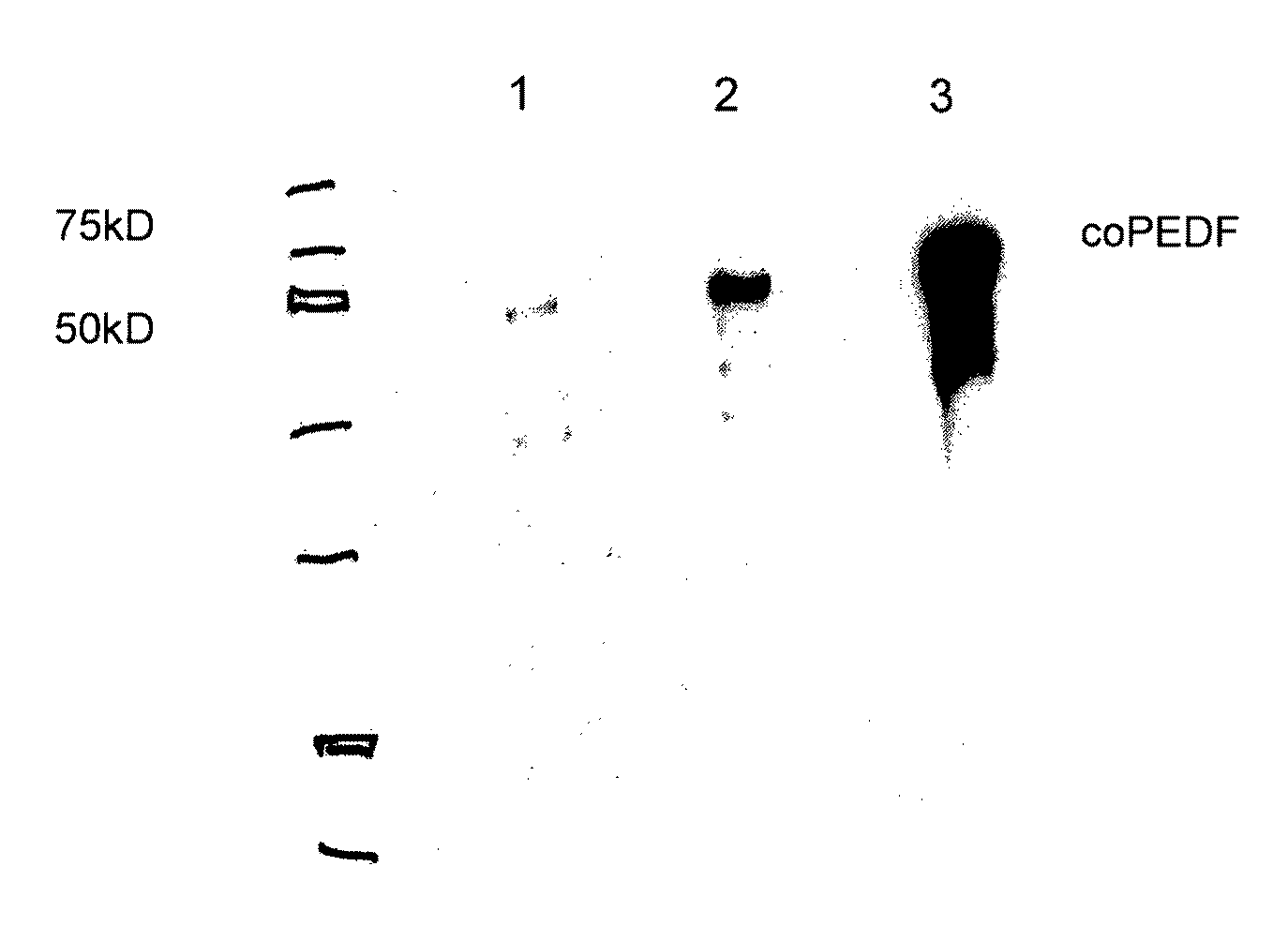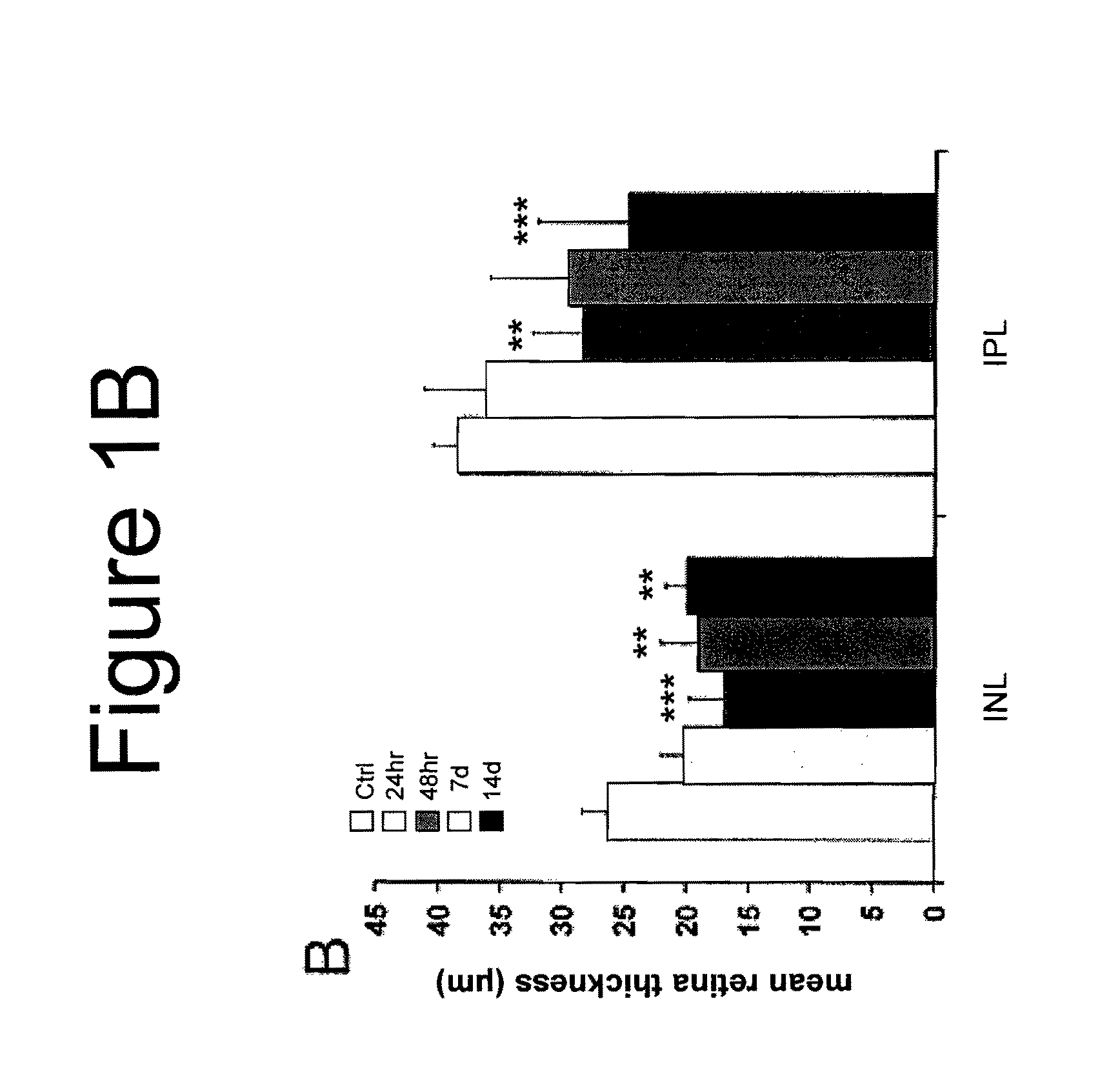Compositions and Methods for Use of Pigment Epithelial Derived Factor (PEDF) Peptide Fragments
a technology of pigment epithelial derived factor and peptide fragment, which is applied in the direction of peptides, drug compositions, angiogenin, etc., can solve the problems of limiting the effectiveness of some forms of delivery for therapeutic applications, subjecting the recipient to additional risk of injury and infection, and severe inflammatory responses to antigenic viral proteins
- Summary
- Abstract
- Description
- Claims
- Application Information
AI Technical Summary
Benefits of technology
Problems solved by technology
Method used
Image
Examples
experimental example 1
Transient Ischemia Reperfusion Injury
[0188]A series of experiments was carried out to measure the extent and time course of retinal damage using the ischemia-reperfusion protocol. C57 / B16 mice exposed to ischemia-reperfusion showed rapid retinal damage by 24 hours and then only little additional change over the next two weeks. Compared to normal retinas (n=9), the thicknesses of inner nuclear layer (INL) in ischemic retinas were reduced to 77.0% at 24 hours (n=5), 64.1% at 48 hours (n=10), 72.6% at 7 days (n=6) and 75.9% at 14 days (n=7) (p value was versus to control group, p<0.01 at all time points) after reperfusion. (FIG. 1B, left side) A similar degree of injury was detected by measuring the changes in thickness of the inner plexiform layer (IPL), which were 93.6%, 73.6% (p<0.01), 76.5% (p<0.05) and 64.2% (p<0.001) of control respectively at the same time points (FIG. 1B, right side). The percentage of surviving cells in the retinal ganglion cell layer showed a more dramatic ch...
experimental example 2
Full Length PEDF Protein Protects RGCs from Ischemic Injury
[0190]The survival of cells in the ganglion cell layer after intraocular injections with PBS (control) or purified PEDF at the time of ischemic injury was assessed. The data show that PEDF protein significantly reduced cell death in the ganglion cell layer at both 48 hours and 7 days post ischemia (FIG. 4). The protective effects of PEDF extended to other retinal layers and prevented the thinning of the IPL that normally occurs after ischemic injury.
experimental example 3
Effect of PEDF Protein and PEDF82-121 on Ischemic Injury
[0191]Experiments were performed to test whether a peptide fragment of PEDF, PEDF82-121, could protect retinal cells to the same extent as PEDF using a single bolus injection at the time of injury. When compared with the non-ischemia control group, at 48 hours after ischemia reperfusion insult, the thickness of the INL, the thickness of the IPL and surviving cells in the RGC layer were reduced to 75.3%, 76.7% and 30.6% respectively in the PBS injected control group (n=6) and 72.6%, 78.1% and 50.7% in the control peptide injected control group (n=5). In the PEDF82-121 injected group (n=6), the same parameters were 100% (p82-121 and PEDF gave substantial protection as compared to either PBS or a control peptide.
[0192]Seven (7) days after injury, INL, IPL thickness and surviving cells in the RGC layer were reduced to 72.4%, 66.8% and 28.2% in PBS injected group (n=6). In the PEDF82-121 injected group (n=6), they were 72.8%, 62.7%,...
PUM
| Property | Measurement | Unit |
|---|---|---|
| Composition | aaaaa | aaaaa |
| Biological properties | aaaaa | aaaaa |
| Therapeutic | aaaaa | aaaaa |
Abstract
Description
Claims
Application Information
 Login to View More
Login to View More - R&D
- Intellectual Property
- Life Sciences
- Materials
- Tech Scout
- Unparalleled Data Quality
- Higher Quality Content
- 60% Fewer Hallucinations
Browse by: Latest US Patents, China's latest patents, Technical Efficacy Thesaurus, Application Domain, Technology Topic, Popular Technical Reports.
© 2025 PatSnap. All rights reserved.Legal|Privacy policy|Modern Slavery Act Transparency Statement|Sitemap|About US| Contact US: help@patsnap.com



